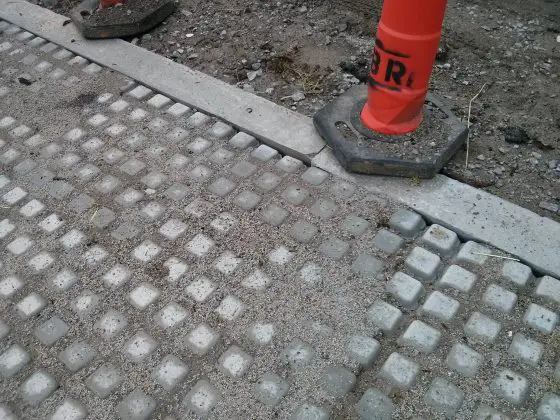Driveway With Grass

This precast concrete paving material allows some rain water to soak back into the soil. While you don’t see grass in between the concrete squares, it will start to grow once seed is broadcast. (C) Copyright 2016 Tim Carter
DEAR TIM: I recently saw a new paving system that I thought was ingenious. Instead of a solid driveway there were two strips of some precast concrete, each about 2-feet wide for the car tires. Grass was growing within the concrete strips and the area between the concrete was just lawn. Back by the person’s garage the entire area was covered with this amazing material allowing grass to grow where the cars would park. What is this new material, is it really strong enough to last and how is it installed? Laura S., Grand Rapids, MI
DEAR LAURA: Believe it or not the idea of just installing strips of paving material instead of solid paving for a driveway is by no means new. It was a very common method of providing a solid driving path for cars in the residential neighborhoods of many of the older cities in the Midwest. Homes nearing 100 years of age had these two strips of concrete and they performed well.
What’s more, the concept of a partial pavement with open spaces for grass or gravel has also been around for many years. There are a host of brand names for this type of paving material and there are some new twists on the original invention that have come to the marketplace. What you saw might have been one of the newest materials.
Recently on a business trip back to my hometown of Cincinnati, Ohio, a very good friend of mine just installed one of these porous paving systems at a small piece of commercial property he owns. The surface reminded me of my wife’s waffle iron.
If you start to do some research into these precast porous paving systems, you’ll quickly discover there are many clever uses for them and they help to recharge the ground water in and around your home and community.
In densely populated urban areas, the vast amount of roof surfaces, sidewalks, streets and parking lots drastically limits the amount of rain that can get into the soil. Paving that’s got holes in it allows lots of rainwater to soak into the soil if it falls slowly enough from the sky.
While I can’t tell you exactly what your material is made from because you didn’t send me a photo, I can say that most are made from high-strength precast concrete. All the products that come in mats or rolls undoubtedly contain reinforcing steel to hold them together. Individual smaller concrete bricks or blocks may not contain steel.
Some of the products can be ordered in different colors other than the standard light gray you see when looking at a new concrete sidewalk, street or driveway. The space and shape between the concrete is different for most of the products. Some will allow more water to soak into the soil faster than others.
The precast concrete is strong, but the thickness of the material alone is not sufficient to support cars and trucks. These thin precast products must be installed very similar to the way you’d install an asphalt or blacktop driveway. The crushed gravel base under an asphalt or blacktop drive or parking lot is what gives it its strength.
The thickness of the crushed gravel under paving material depends on the weight of the vehicles that will drive onto the finished surface. For example, if you use these unique precast concrete pavers on a golf course where lightweight golf carts travel with wide balloon tires, you might get by with just 3 inches of crushed gravel. If you want to use these materials on a city street where large heavy trucks travel, an engineer might specify 12, or more, inches of special compacted crushed gravel!
The actual installation method varies for the product you decide to use and what you want the finished surface to look like. You may desire grass to grow in between the blocks of precast concrete, but this would never work for someone who wants to use these in an arid climate where it rarely rains. They’ll probably install small colorful crushed gravel in between the concrete the car and truck tires contact.
Realize these materials get their strength from the base beneath them. This means that their long-term durability depends on how well you, or your contractor, follows the instructions for installing them and how strong the subsoil is under the surface.
Most installations call for you to excavate away any top soil that contains organic material. The depth of the excavation depends on the combined thickness of the crushed gravel, any special soil and sand mix that might be called for, and the actual pre-cast paving material. Pay very close attention to any instructions with regards to the maximum thickness the crushed gravel layers can be should you have to install lots of the material. Often it should not be installed more than 4 inches at a time.
Sprinkling water on the crushed gravel as it’s being installed and compacted might be in the specifications. This helps make it very strong, but don’t overwater it.
Column 1166